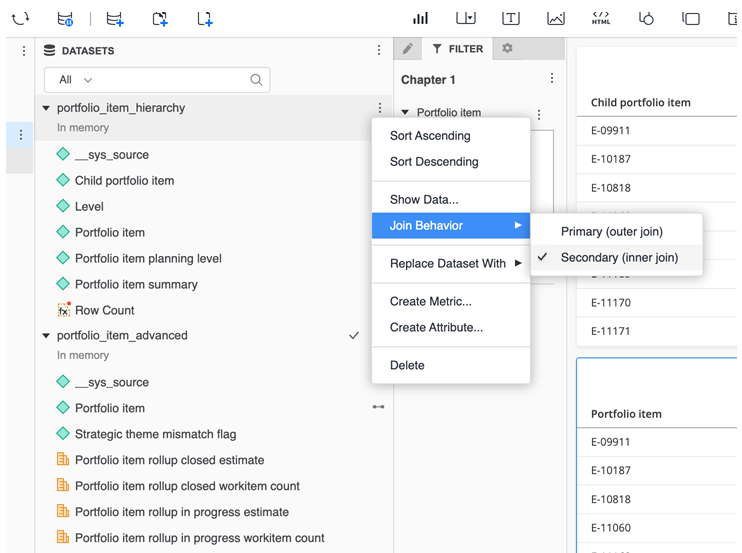Planning Level Hierarchy
The planning level hierarchy dataset structures data across various planning levels within an organization. This is useful for strategic planning, resource allocation, and more. This structure aids in organizing and managing different planning activities, providing clear responsibilities and timelines.
You can use this dataset to obtain planning level metrics that consider all work items connected to the selected planning level and its child planning levels.
Example: By combining the planning level hierarchy (child planning level) and work item base (work item planning level) datasets, applying a filter on the planning level (planning level hierarchy) dataset rolls up the metrics to the selected planning level and all of its child planning levels. This method includes only in-context items.
The following are the components of this dataset:
| Attribute Name | Description |
|---|---|
| Child planning level | Name of the child planning level that is created under a parent planning level |
| Parent planning level | Parent Planning level Name of the Planning level hierarchy |
| Planning level | Name of the planning level |
| Planning level end date | The date when a specific planning level is scheduled to end or become inactive. |
| Planning level hierarchy path | Path of the Planning Level Hierarchy |
| Planning level schedule flag | Schedule flag of the planning level |
| Planning level start date | The date when a specific planning level begins or becomes active. |
| Planning level URL | A hyperlink directing to the detailed view or relevant page of the specified planning level. |
| Level | Depth of hierarchy |
| Sys_source | Unique identifier for the source |
This dataset doesn’t have any metrics.
Blending of Hierarchical Datasets with Other Datasets
When blending a hierarchical dataset with another dataset using the child element of the hierarchy, there is a possibility that the child may not exist or be eligible in the secondary dataset. In this process, the planning level filter is applied to the parent of the hierarchical dataset, while the child is joined to the other dataset. However, the child dataset applies the planning level filter directly to the child element. This can result in the hierarchical dataset retrieving more child records than the child dataset, which may lead to null values for missing or ineligible records.
To resolve this issue, the join type for the hierarchical dataset should be adjusted from the default Outer Join to an Inner Join.
For example, when blending the Portfolio Item Hierarchy dataset with the Portfolio Item Advanced dataset to retrieve the Strategic Theme Mismatch Flag, NULL records may appear. This occurs because the number of child portfolio item records in the Portfolio Item Hierarchy is less than the number of portfolio items in the Portfolio Item Advanced dataset. This mismatch causes null records when trying to fetch the Strategic Theme Mismatch Flag for the child based on the parent portfolio item. To avoid this, after blending, the "Join Behavior" of the hierarchical dataset should be changed from "Primary (Outer Join)" to "Secondary (Inner Join)."
